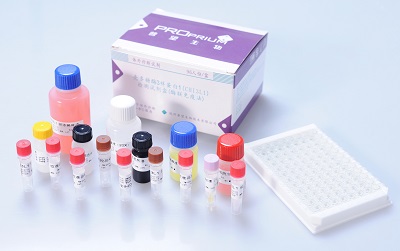
The Proprium® Fibro-CHI Diagnostic Kit—for the quantification of Chitinase 3-Like 1 (CHI3L1) in serum and plasma
CHI3L1 (Chitinase 3-like 1, also known as YKL-40) is a member of the chitinase family but lacks chitinase activity; it encodes a glycoprotein that is a member of the 18-glycosyl hydrolase family [4]. The function of this glycoprotein is unclear, but it has been hypothesized that CHI3L1 plays a role in both inflammation and tissue remodeling [4]. Immunohistochemic al analysis demonstrated positive staining for CHI3L1 antigens in areas with fibrosis, particularly areas with active fibrogenesis. Expression profiling using the highly sensitive and digital nature offered by the next-generation sequencing technologies revealed that CHI3L1 is a abundantly expressed, and a liver-specific or a highly liver-enriched gene. From the data from the Illumina Human Body Map 2.0 (http://genomicdbdemo.bxgenomics.com/), the level of expression of CHI3L1 in the liver is 15.3-fold (compared with that in the kidney) to 276-fold higher (compared with that in the heart) than its level of expression in other tissues [5].
The Proprium® Fibro-CHI Diagnostic Kit Characteristics--Passed the Chinese FDA Quality Assessment
►Testing Time: 3 hours for ELISA and 18 minutes for CLIA.
►Testing principle: Offered in two formats: ELISA (enzyme-linked immunosorbent assay) or CLIA (Chemiluminescence immumoassay)
►Sample Material: Serum collected using standard sampling tubes or tubes containing separating gel
►Sample Volume: 5uL serum (500-fold dilution for ELISA, 50-fold dilution for CLIA)
►Detection limit (defined by LoD): 0.035ng/mL
►Measuring range: 0.035-1.2ng/mL
►Batch-to-Batch variability: Coefficient of variation < 15%.
►Linearity: Correlation coefficient r > 0.9900
►Repeatability: 10 measurements of low- and high-concentration standards yield coefficient of variation < 15%.
►Stability test: Stable after incubation for 3 days at 37 °C.
The product is CFDA approved for clinical use in China and CE marked for IVD use in CE-marking countries (e.g. European countries).
A novel diagnostic marker with increased sensitivity for advanced liver fibrosis (cirrhosis)
►Serum CHI3L1 levels were increased in alcoholic cirrhosis, post-hepatitic cirrhosis and non-cirrhotic fibrosis [6].
►Several studies have established that CHI3L1 is a biomarker for HCV-induced liver fibrosis and cirrhosis [6-9].
►CH13L1 was shown to be a biomarker for HBV-related liver fibrosis and cirrhosis [5].
Figure 1. A comparison of ROC curves between CHI3L1 (left) and Fibroscan and other biomarker panels (right) used or in development.
Table 1. A comparison of the sensitivities and specificities in the diagnosis of cirrhosis using CHI3L1 and the 4-biomarker panel.
| The 4-biomarker panel | CHI3L1 | |
| Sensitivity | 60-70% | 92.4% |
| Specificity | 90% | 89.3% |
| Assays needed | 4 | 1 |
Good discrimination for different stages of liver fibrosis using CHI3L1
According to several international and Chinese guidelines for the treatment of chronic liver diseases, including HBV infection, accurate determination of fibrosis stages is critical for optimizing the timing of antiviral treatment [10, 11]. In a study conducted at Zhejiang Provincial People's Hospital, the first Affiliated Hospital of Zhejiang University and the Second Affiliated Hospital of Zhejiang University, Hangzhou, China, 92 biopsy-confirmed stage S0 and S1 liver fibrosis patients, 31 biopsy-confirmed stage S2 liver fibrosis patients and 153 advanced stage liver fibrosis (S3-S4) were enrolled. The median levels of serum CHI3L1 is 46.3 with the upper 95% CI at 50.4 for stage S0-1 and 56.8 with the upper 95% CI at 76.2 for S2 liver fibrosis (Table 2). A cutoff value of 76.2 could be used to identify liver fibrosis at stage S2 or less. The differences between stage S0_1 and S2 patients, and between stage S2 and S3_4 patients are both statistical significant (P<0.05, the Mann-Whitney test).
Table 2. The median levels of CHI3L1 in different stages of liver fibrosis
| Stages | N | Median | 95% CI |
| S0_1 | 92 | 46.330 | 40.830 - 50.440 |
| S2 | 31 | 56.820 | 47.902 - 76.240 |
| S3_4 | 153 | 188.800 | 169.408 - 228.196 |
References
1. Pellicoro, A., et al., Liver fibrosis and repair: immune regulation of wound healing in a solid organ. Nat Rev Immunol, 2014. 14(3): p. 181-94.
2. Liao, B., et al., Significant fibrosis is not rare in Chinese chronic hepatitis B patients with persistent normal ALT. PLoS One, 2013. 8(10): p. e78672.
3. Xu, J., et al., [Relationship between the genotypes of hepatitis B virus and the severity of liver diseases]. Zhonghua Gan Zang Bing Za Zhi, 2003. 11(1): p. 11-3.
4. Libreros, S., R. Garcia-Areas, and V. Iragavarapu-Charyulu, CHI3L1 plays a role in cancer through enhanced production of pro-inflammatory/pro-tumorigenic and angiogenic factors. Immunol Res.
5. Huang, H., et al., CHI3L1 Is a Liver-Enriched, Noninvasive Biomarker That Can Be Used to Stage and Diagnose Substantial Hepatic Fibrosis. OMICS an Journal of Integrative Biology, 2015. 19(6): p. 339-345.
6. Johansen, J.S., et al., Serum YKL-40 is increased in patients with hepatic fibrosis. J Hepatol, 2000. 32(6): p. 911-20.
7. Tran, A., et al., Chondrex (YKL-40), a potential new serum fibrosis marker in patients with alcoholic liver disease. Eur J Gastroenterol Hepatol, 2000. 12(9): p. 989-93.
8. Nojgaard, C., et al., Serum levels of YKL-40 and PIIINP as prognostic markers in patients with alcoholic liver disease. J Hepatol, 2003. 39(2): p. 179-86.
9. Kamal, S.M., et al., Progression of fibrosis in hepatitis C with and without schistosomiasis: correlation with serum markers of fibrosis. Hepatology, 2006. 43(4): p. 771-9.


